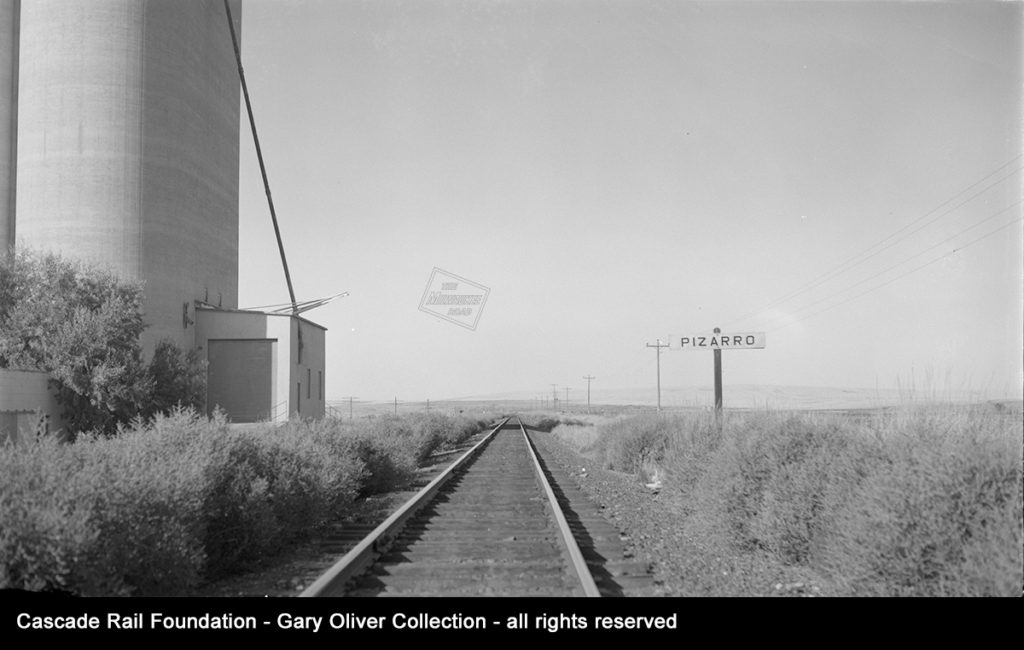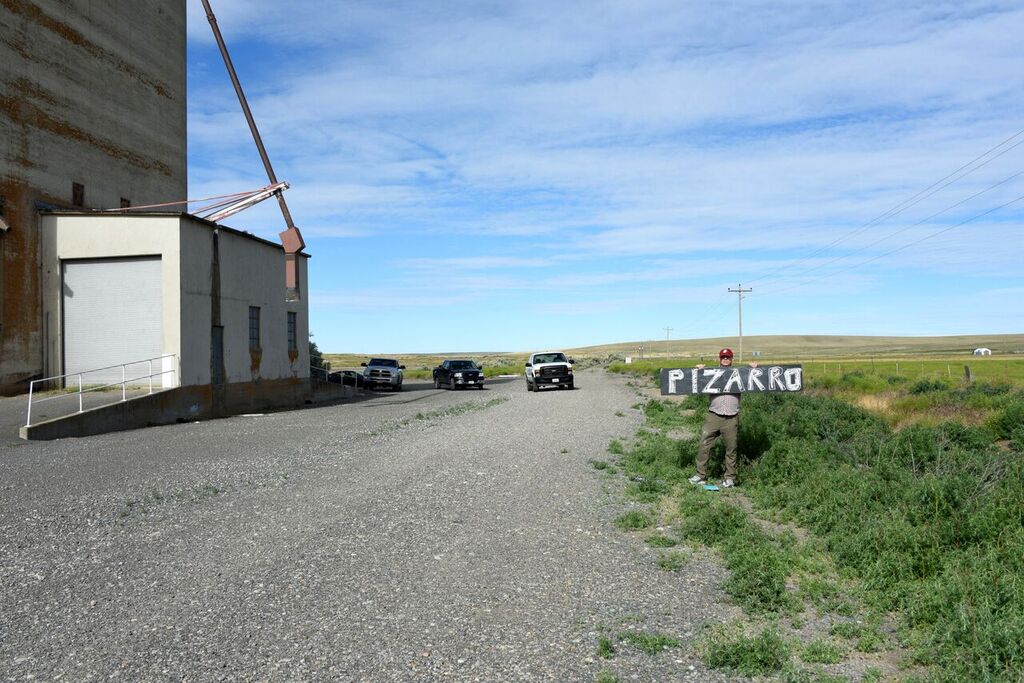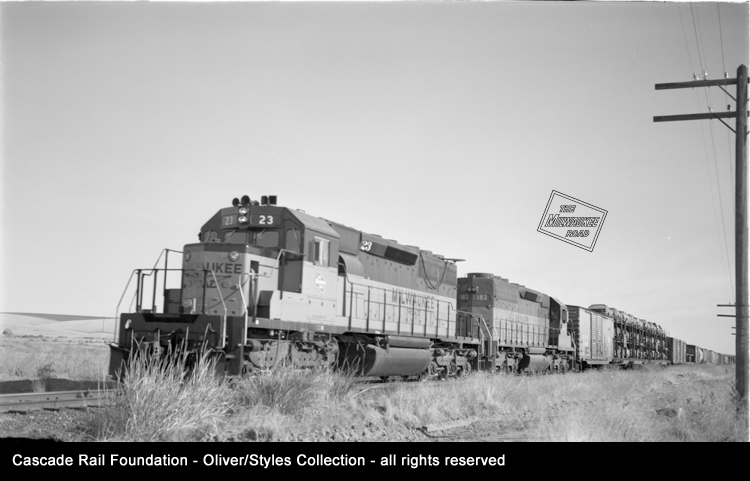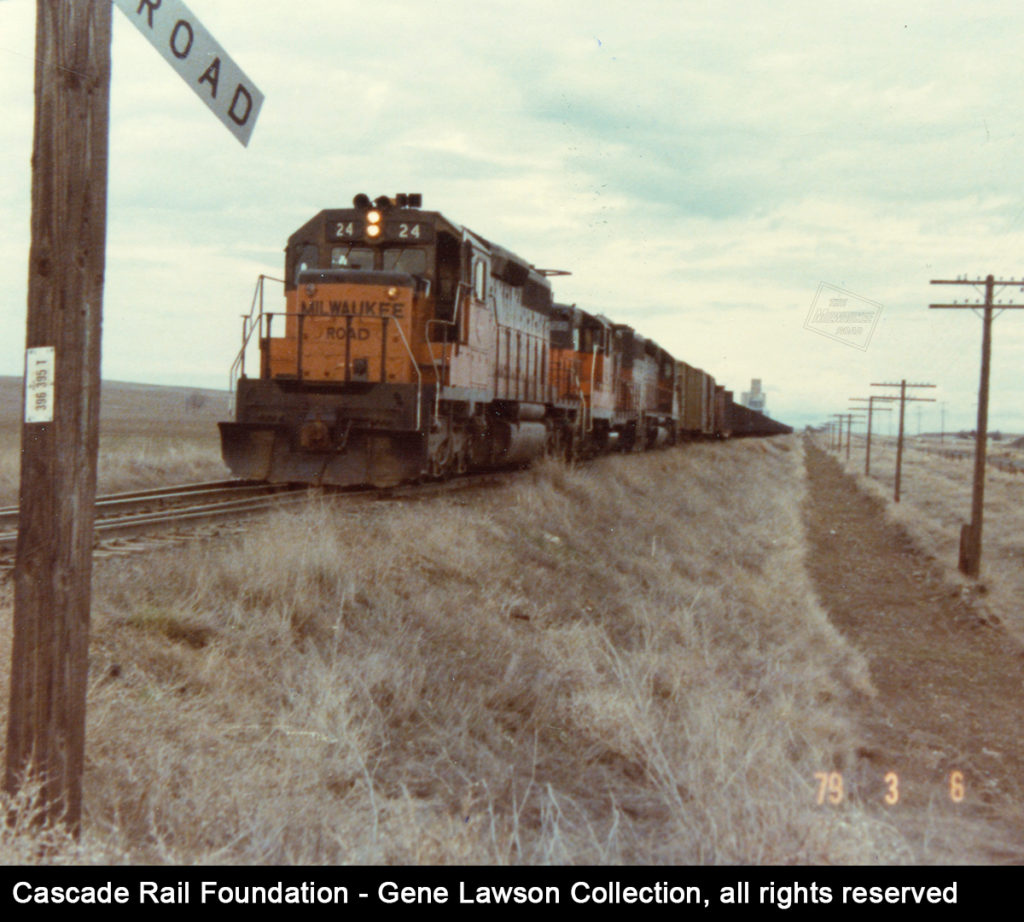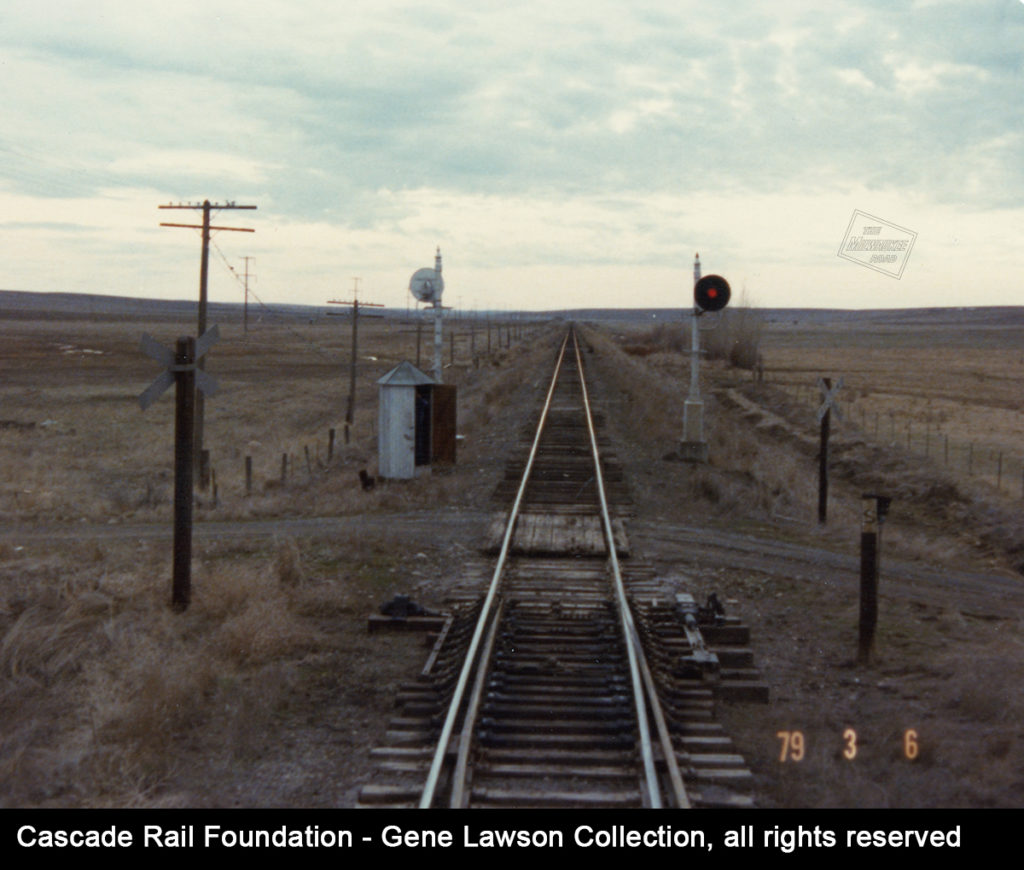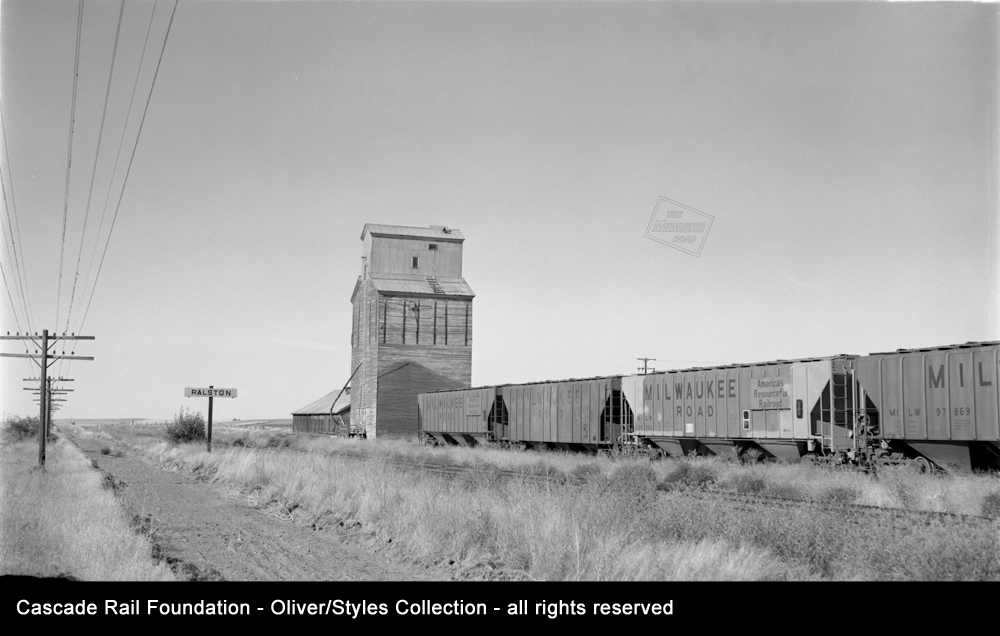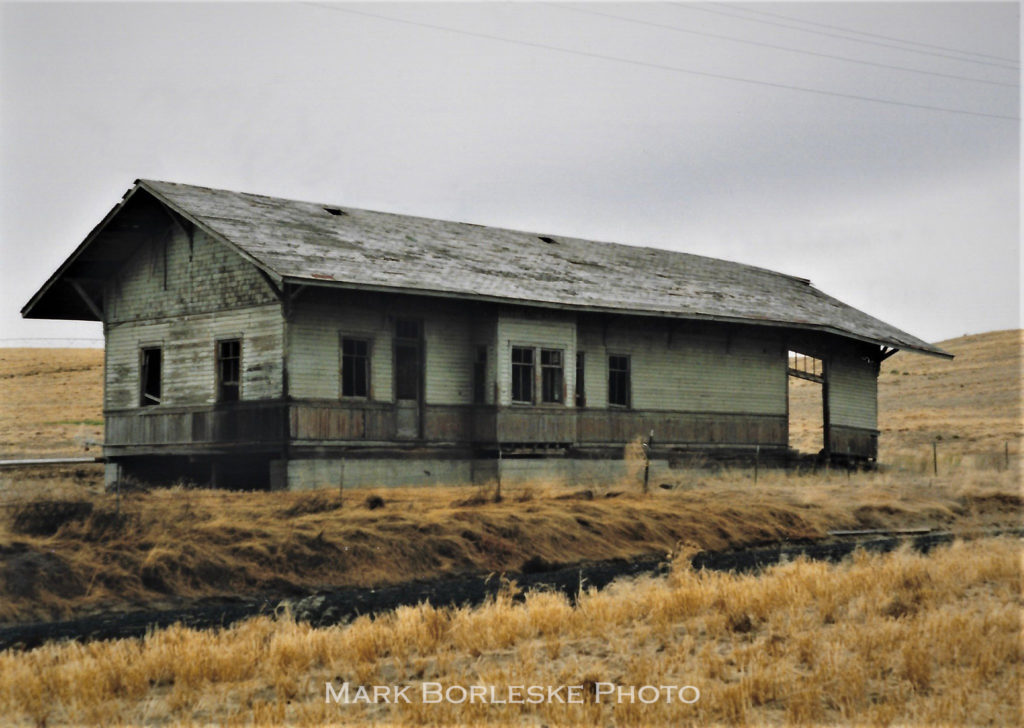Leaving Lind, today we’re traveling the Lind Coulee in the channeled scablands, a land known for considerable dryland farming. Grain elevators appear in even the smallest of communities. We travel along a pole line, one that is remarkably intact even into the 21st century. We end up at Ralston, where there was a depot agency, a water tower, pump house, and over the years a succession of grain sack houses and elevators.
PIZARRO
Pizarro, WA is an example of one of those small communities with a grain elevator . This location was named after Rudolphus Pizzaro Smith. Originally it was named Smith’s Spur, but in May 1911 it was renamed Pizzaro. Mr. Smith’s son Warren loaded grain here his entire life. This view of Pizarro looks west, toward Lind just under 10 miles away, in August 1975. Photo probably taken by Stan Styles, in the Cascade Rail Foundation Gary Oliver collection. Caption information from Allen Miller.
This view of Pizarro from June 30, 2018 shows how little things have changed over time, except for the removal of the railroad. This photo was part of a site visit on behalf of a Cascade Rail Foundation volunteer project for Washington State Parks on the Palouse to Cascades Trail. Reproduction station signs, 75% the size of the originals, will be located at “named points” and depot sites between Lind and Idaho line. The pilot project calls for instalation of signs from Lind to Ralston as soon as volunteers are allowed. Mark Borleske is seen here marking the spot where the Pizarro sign will be located.
We welcome donations for this project of roughly 20 signs over a 100 mile distance. Do you want to sponsor your very own place on the Milwaukee Road? A full sign sponsorship is $400. Visit our donation page to make a donation and we will follow up with you or contact us if you have a particular location in mind before making a donation. Dan Bolyard photograph.
Before we leave Pizarro, we see a train rolling through. Here EMD SD40-2 23 leads a westbound freight at Pizarro in August 1975. Photo probably taken by Stan Styles, in the Cascade Rail Foundation Gary Oliver collection.
RALSTON
Moving east we head to Ralston, WA, another small community with a grain elevator. Milwaukee Road SD40-2 number 24 is leading a westbound train at the west switch of the Ralston siding in 1979. This may be a Marengo Turn, with a long string of empty hoppers returning to Utah through the UP interchange at Marengo. Photo taken by Milwaukee Road engineer Gene Lawson as he looks back at his train from the Bauman Road grade crossing. Gene Lawson photo in the Cascade Rail Foundation Gene Lawson Collection.
Engineer Gene Lawson also captured a view looking east here from his westbound train at the west switch of the Ralston siding in 1979. This photo clearly shows the details of the end of a passing track, as well as the Bauman Road grade crossing. The block signals, the hand throw switch, and “S” as an indicator that it is a spring switch From the multi-sided phone box with the door open, the fireman or head brakeman has been on the company phone to communicate with the train dispatcher. The train crew is probably trying to find out if another train is occupying the track ahead of them or if the signal has a problem. If the signal is malfunctioning, the dispatcher will call the signal maintainer. Phone boxes like this were typical near the ends of passing tracks, especially before train radio became dependable and nearly universally used. Gene Lawson photo in the Cascade Rail Foundation Gene Lawson Collection. Caption information from Ryan Reed.
Turning the clock farther back in time, we see Ralston looking west in this John Barriger III photo taken during his inspection tour of September 1936. The depot is ahead, water tank on left side of tracks. The still-standing (and rehabilitated) pump house for the 306-foot deep well the Milwaukee Road used to get water here is obscured behind the depot and trees. Grain was shipped from the industry track on the left, with boxcars awaiting loading and movement out. Photo from the John W. Barriger III National Railroad Library.
The grain elevator at Ralston is seen in this photo from August 1975. The configuration of grain elevators and sack houses, as well as the methods of shipping grain, changed over time. Grain shipments by rail started as sacked wheat in boxcars, then moved to bulk grains in boxcars with door inserts (first wood and later paper inserts) and hopefully tight walls, and finally transitioned to bulk 100-ton capacity covered hoppers. After the Ralston depot was removed, a station sign sufficed to identify this location. The pole line is relatively intact along the right of way to Ralston. Photo probably taken by Stan Styles, in the Cascade Rail Foundation Gary Oliver collection.
The Ralston depot was moved off the property and relocated in a farmer’s field. It was open on the baggage side (right) and it deteriorated over a long period of time. Years later the building suffered collapse and no trace remains. This photo shows how it looked on September 25, 1998. Mark Borleske photo.
NEXT STATION…
Tomorrow we continue east to see the illusive crossing of Cow Creek and the remote junction at Marengo.


